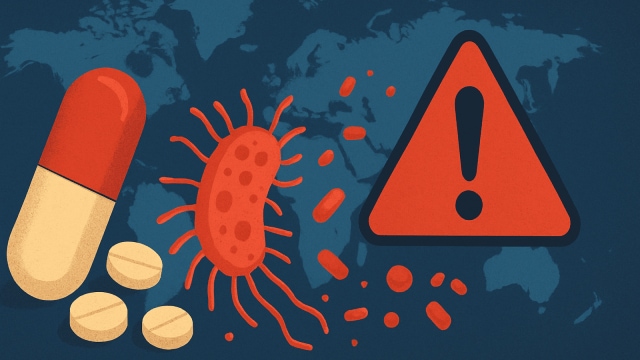📣 For more lifestyle news, click here to join our WhatsApp Channel and also follow us on Instagram
Your usual treatments for diseases may not work anymore, WHO warns antibiotic resistance is ‘critically high’ globally
The WHO has warned that antibiotic resistance is critically high and rising globally, threatening life-saving treatments and exposing gaps in health systems.
 Antimicrobial resistance (AMR) is one of the 10 top global health threats, the WHO says (AI image used for representation only).
Antimicrobial resistance (AMR) is one of the 10 top global health threats, the WHO says (AI image used for representation only).Did you have to go through a phase in which you were taking medicines and undergoing treatments, but nothing seemed to work. That may well be the result of your body developing a resistance to medicines. The World Health Organization (WHO) on Tuesday released a comprehensive analysis on a global antimicrobial resistance (AMR) crisis. The WHO report revealed a dire situation — resistance to life-saving medicines is “critically high and rising”, particularly in resource-limited settings.
This means that the usual treatments that you undergo for many common diseases and infections, such as Urinary Tract Infection (UTI) and gastrointestinal ailments, may be ineffective.
The Global Antibiotic Resistance Surveillance Report 2025, compiled by the WHO Global Antimicrobial Resistance and Use Surveillance System (GLASS), is based on an unprecedented analysis of over 23 million bacteriologically confirmed infections reported by 104 countries. The report offers global, regional, and national estimates of antibiotic resistance trends, which are a threat to human health and modern treatment methods.
“Antimicrobial resistance (AMR) is one of the 10 top global health threats, undermining the effectiveness of essential treatments and placing millions at risk of untreatable infections,” the report said.
Key Findings of WHO report on antibiotic resistance:
1. High antibiotics resistance is the Global Reality
The report confirms that global antibiotic resistance levels are extensive and unevenly distributed across regions. Around one in six bacterial infections (confirmed in laboratories) worldwide were caused by bacteria resistant to antibiotics in 2023.
Urinary Tract Infections (UTIs) most compromised: The average antibiotic resistance was highest in UTIs. This affected 1 in 3 patients.
Bloodstream Infections (BSIs) a major concern: About 1 in 6 BSIs were found to be antibiotic resistant. The effectiveness of first-choice treatments for common infections of the bloodstream, urinary tract, and gastrointestinal tract is increasingly being compromised.
Gram-Negative threat: Increasing antibiotic resistance trends in Gram-negative bacterial pathogens, such as E coli and Klebsiella pneumoniae, pose a growing threat and are a major source of concern, as per the report.
2. Disproportionate burden on the most vulnerable
According to the WHO report, the AMR crisis is not affecting all countries equally. While some are impacted more, others have been able to mitigate the crisis, the WHO found. This has created a “syndemic of resistance and weak health systems” that disproportionately impacted the most vulnerable populations.
Impact on low-income group: The burden of AMR was observed to be the highest in low- and middle-income countries (LMICs) and those with weak health systems. This inequality highlights an urgent need for investment in healthcare systems, particularly for infection prevention and access to timely, quality diagnosis and treatment.
Surveillance paradox: The report found that countries with limited capacity for health surveillance often reported higher levels of antibiotic resistance. However, this was mostly a result of sampling bias, where data is collected mainly from a few tertiary hospitals that treat the most severe cases or patients who have already failed initial treatments, leading to an overestimation of the true impact of AMR.
3. Global monitoring up, but gaps persist
The global effort to track the crisis is expanding, although significant regional voids remain. Country participation in the WHO GLASS system has increased four-fold since 2016. By 2023, 104 countries contributed to the data, a rise of over 300% since the system’s first year of data collection in 2016.
The report stated antibiotic resistance was “most frequent in the South-East Asia and Eastern Mediterranean regions (almost 1 in 3 infections), followed by the African Region (1 in 5), all above the global median. Resistance was less frequent in the European Region (1 in 10) and least frequent in the Western Pacific Region (1 in 11), indicating wide regional disparity”.
Between 2016 and 2023, the national AMR surveillance coverage rose across the world for bloodstream, urinary tract, and gastrointestinal infections. The surveillance considered the number of infections with antimicrobial susceptibility test (AST) results reported per million population.
Despite this progress, regional gaps persist. Participation remains lowest in the Americas and the Western Pacific region. Moreover, more than half of the reporting countries still lack the basic infrastructure, such as quality assurance and adherence to international AST standards, necessary to generate reliable, comprehensive AMR data, the WHO report pointed out.
The WHO has urged countries to step up efforts to meet global targets, including ensuring that at least 70% of human antibiotic use is from the WHO AWaRe (Access, Watch, Reserve) “Access” group of antibiotics by 2030. This target was set by the 2024 United Nations General Assembly Political Declaration on AMR.
📣 For more lifestyle news, click here to join our WhatsApp Channel and also follow us on Instagram



- 01
- 02
- 03
- 04
- 05

























